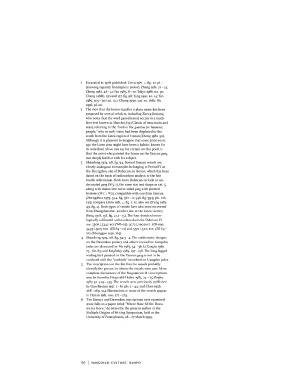Page 68 - The Golden Age of Chinese Archaeology: Celebrated Discoveries from the People’s Republic of China
P. 68
1 Excavated in 1978; published: Linru 1981, 4, fig. 1:1; pi. i
(showing repairs); frontispiece (color); Zhang 1981, 21-24;
Zheng 1982, 48-51; Fan 1983, 8-10; Tokyo 1986, no. 30;
Chang i986b, 130 and 137, fig. 98; Yang 1991, no. 14; Yan
1989, 303-307; pi. 12:1; Chang 1990, cat. no. 1682; Wu
1996, pi. 20.
2 The view that the heron signifies a place name has been
proposed by several scholars, including Zheng Jiexiang,
who notes that the word guan (heron) occurs in a much
later text known as Shan hai jing (Classic of mountains and
seas), referring to the "land of the guantou (or huantou)
people," who in early times had been displaced to the
south from the Linru region of Henan (Zheng 1982, 50).
Although it is pleasant to imagine that some 5000 years
ago the Linru area might have been a habitat known for
its waterfowl, all we can say for certain on this point is
that the artist who painted the heron on the Yancun gang
was deeply familiar with his subject.
3 Shandong 1974,118, fig. 94. Several Yancun vessels are
closely analogous to examples belonging to Period IV at
the Zhengzhou site of Dahecun, in Henan, which has been
dated on the basis of radiocarbon analysis to the late
fourth millennium. Finds from Dahecun include an un-
decorated gang (W3: i), the same size and shape as cat. 5,
along with distinctive curve-sided ping with pointed
bottoms (Wi: i; W2), compatible with one from Yancun
(Zhengzhou 1979, 344, fig. 36:1-2; 346, fig. 39:5; pis. 11:6,
13:9; compare Linru 1981, 4, fig. i: 10; also see Zheng 1982,
49, fig. 2). Both types of vessels have also been recovered
from Zhangshanzhai, another site in the Linru vicinity
(Fang 1978,138, fig. 2:12-13). The four dendrochrono-
logically calibrated radiocarbon dates for Dahecun IV
are: 3506±3342 BCE (WB-O3); 3O72±29O2BCE (ZB-O9);
3493±3109 BCE (ZB 84-21) and 3371 ±3101 BCE (ZB84-
22) (Zhongguo 1991,165).
4 Shandong 1974,118, fig. 94:3-4. The emblematic designs
on the Dawenkou pottery and others incised on Liangzhu
jades are discussed by Wu 1985, 34-36; Li Xuegin 1987,
75-80, 85; and Keightley 1989,197-198. The long-legged
wading bird painted on the Yancun gang is not to be
confused with the "sunbirds" inscribed on Liangzhu jades.
5 The inscriptions on the Bei Dan Ge vessels probably
identify the person for whom the vessels were cast. More
complete discussions of the Wuguancun M i inscriptions
may be found in Fitzgerald-Huber 1983, 24-25; Bagley
1987, 52, 429-435. The vessels were previously published
by Guo Baojun 1951,1-61; pis. 1-44; and Chen 1956,
268-269, 3HJ Illustrations of some of the vessels appear
in Henan 1981, nos. 272-274.
6 The Yancun and Dawenkou inscriptions were examined
more fully in a paper titled "Where Have All the Docu-
ments Gone," delivered by the present author at the
Multiple Origins of Writing Symposium, held at the
University of Pennsylvania, 26-27 March 1999.
67 | YANCSHAO CULTURE: BANPO

